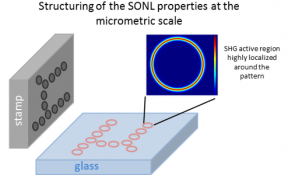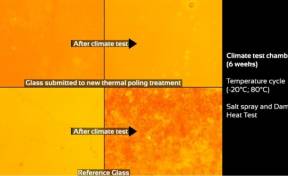
New generations of microgels comprising multiple properties

Domaine Sécurité
Technologie Métaomique
Challenges
The formation of microgels could be complex.
Spontaneous self-assembly in cohesive/self-supported films (on skin).
Encapsulation and release are the challenges to ensure an efficient delivery and the penetration of compounds through the primary skin barrier.
Innovative solution
The invention relates to a method of preparing and using the on-demand microgel compositions/functionality. These versatile process and new generation of microgels are able to overcome the current challenges regarding formation, penetration, encapsulation and release.
APPLICATIONS
-
Cosmetic
-
Medical device
-
Pharmaceutical
-
Mechanical sensor
COMPETITIVES ADVANTAGES
-
Film formation on any substrate: glass, skin, etc.
-
Strong film cohesion even when submerged
-
Adhesion in humid environment
-
Facilitated encapsulation / Nature of the active ingredient (hydrophobic, hydrophilic, peptide, biomacromolecules)
-
Controlled release of active molecules (pH, T °, hydrophobicity, etc.)
-
Mechanoelectric stimulus
DEVELOPMENT STATUS
-
4 generations of functional microgels and their homologues in films
-
Biodegradable microgels underway
-
Fully biobased biodegradable microgels to be done
How it works
New generations of microgels behave as soft micro-sponges with high functionalities due to the versatility of the waterborne chemical process to prepare them.
Compared to macroscopic gels, microgels are defined by singular physico-chemical properties. Microgels are environmentally responsive cross-linked colloidal particles able to form stable aqueous colloidal dispersions, swell rapidly in a thermodynamically good solvent and respond to external stimuli (temperature, pH, ionic strength...). In addition, the microgels’ surface area is by far larger than macroscopic gels’ one increasing the area of the electrical double layer. What is more, these colloidal systems present an extraordinary ability to contain therapeutic molecules, such as hydrophobic & hydrophilic molecules, or even macromolecules, due to their sponge’s structure and release them in solution by changing their volume.

Indeed, the design & control of the microgels morphologies tend to well-control their swelling/deswelling ability to encapsulate/release active ingredients by tuning the nature of the interactions (VdW, electrostatic, steric hindrance …).
The success of the challenge of stabilizing self-assembled microgel films” SAMFs requires the combination of two opposite phenomena. The colloidal stability of microgel particles and hence, their individual state, is originated from electrostatic repulsive forces with their additional solvation forces between microgel particles to allow their assembly and avoid their post-dispersion in contact with water. In this sense, many efforts have been made to stabilize highly hydrophilic self-assembled microgels films by the creation of electrostatic or covalent interactions between particles, requiring catalytic conditions, successive steps/long-period casting to induce efficient microgels self-cross-linking. Such conditions may be harmful for humans being not suitable for epidermal applications where the spontaneous and in situ film-formation is required. Herein, the tuning of the microgels outer shell, i.e. hairy shell, permits to self-assemble the microgels by water evaporation (i.e. skin temperature or higher) into cohesive/self-supported films with mechanical strength & mechano-electrical.

IP CHARACTERISTICS
|
IP |
Title |
Advantages |
|
15703307.7 WO 2016/110615 |
Process of care or make up using poly(ethylene glycol) methacrylate microgels |
Process for the formation of biocompatible microgels (thermosensible and ph-responsiveness) that can incorporate active ingredients. These microgels show very advantageous optical and electromechanical properties. |
|
17196940.5 PCT/IB2018/001212 |
Microgels for the delivery of cosmetic active organic substances |
Enhancement of the encapsulation/release of the microgels |
|
FR1913338 |
Microgels and their photonic applications and stimulable interference |
Original color effects which can be alternative or complementary to those of conventional pigments and dyes |
|
FR1914550 FR1914551 |
Composition or medical device comprising oligo(ethylene glycol)-based polymers |
New way of modulating the mechanical properties of films that are intended to be applied to the mucous membranes or to the skin. |
|
US201962855687P PCT/US2020/035378 |
Mucoadhesive microgel compositions and methods for using the same |
Mucoadhesive microgel compositions for therapeutic applications |
|
EP21305379.6 |
Conductive stimuli-responsive colloidal microgels and their film homologues: Synthesis using catechol groups as crosslinking and doping agents, and |
Mechano-electrical films obtained from mucoadhesive conductive microgels waterborne dispersion |
Inventeurs
Developed by Laurent Billon: IPREM (UPPA, CNRS)
Propriété intellectuelle
5 patent families
- 15703307.7 - WO 2016/110615 : Process of care or make up using poly(ethylene glycol) methacrylate microgels.
- 17196940.5 - PCT/IB2018/001212 : Microgels for the delivery of cosmetic active organic substances.
- FR1913338 : Microgels and their photonic applications and stimulable interference.
- FR1914550 - FR1914551 : Composition or medical device comprising oligo(ethylene glycol)-based polymers.
- US201962855687P - PCT/US2020/035378 : Mucoadhesive microgel compositions and methods for using the same.
- EP21305379.6 : Conductive stimuli-responsive colloidal microgels and their film homologues: Synthesis using catechol groups as crosslinking and doping agents, and mechano-electrical properties.
PARTERSHIPS
Licensing
Contact
Carlos LARRAYA
%63%2e%6c%61%72%72%61%79%61%40%61%73%74%2d%69%6e%6e%6f%76%61%74%69%6f%6e%73%2e%63%6f%6d
+33 (0)5 33 51 43 11



